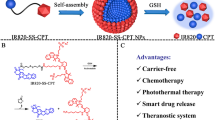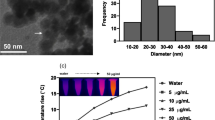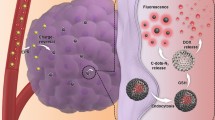Abstract
Purpose
Paclitaxel (PTX) loaded hydrophobically modified glycol chitosan (HGC) micelle is biocompatible in nature, but it requires cancer targeting ability and stimuli release property for better efficiency. To improve tumor retention and drug release characteristic of HGC-PTX nanomicelles, we conjugated cancer targeting heptamethine dye, MHI-148, which acts as an optical imaging agent, targeting moiety and also trigger on-demand drug release on application of NIR 808 nm laser.
Procedures
The amine group of glycol chitosan modified with hydrophobic 5β-cholanic acid and the carboxyl group of MHI-148 were bonded by 1-ethyl-3-(3-dimethylaminopropyl)carbodiimide/N-hydroxysuccinimide chemistry. Paclitaxel was loaded to MHI-HGC nanomicelle by an oil-in-water emulsion method, thereby forming MHI-HGC-PTX.
Results
Comparison of near infrared (NIR) dyes, MHI-148, and Flamma-774 conjugated to HGC showed higher accumulation for MHI-HGC in 4T1 tumor and 4T1 tumor spheroid. In vitro studies showed high accumulation of MHI-HGC-PTX in 4T1 and SCC7 cancer cell lines compared to NIH3T3 cell line. In vivo fluorescence imaging of the 4T1 and SCC7 tumor showed peak accumulation of MHI-HGC-PTX at day 1 and elimination from the body at day 6. MHI-HGC-PTX showed good photothermal heating ability (50.3 °C), even at a low concentration of 33 μg/ml in 1 W/cm2 808 nm laser at 1 min time point. Tumor reduction studies in BALB/c nude mice with SCC7 tumor showed marked reduction in MHI-HGC-PTX in the PTT group combined with photothermal therapy compared to MHI-HGC-PTX in the group without PTT.
Conclusion
MHI-HGC-PTX is a cancer theranostic agent with cancer targeting and optical imaging capability. Our studies also showed that it has cancer targeting property independent of tumor type and tumor reduction property by combined photothermal and chemotherapeutic effects.






Similar content being viewed by others
References
Hervault A, Thanh NT (2014) Magnetic nanoparticle-based therapeutic agents for thermo-chemotherapy treatment of cancer. Nano 6:11553–11573
John JV, Thomas RG, Lee HR, Chen H, Jeong YY, Kim I (2016) Phospholipid end-capped acid-degradable polyurethane micelles for intracellular delivery of cancer therapeutics. Adv Healthcare Mater 5:1874–1883
Ramachandra Kurup Sasikala A, Thomas RG, Unnithan AR, Saravanakumar B, Jeong YY, Park CH, Kim CS (2016) Multifunctional Nanocarpets for cancer Theranostics: remotely controlled graphene Nanoheaters for Thermo-Chemosensitisation and magnetic resonance imaging. Sci Rep 6:20543
Yue C, Zhang C, Alfranca G, Yang Y, Jiang X, Yang Y, Pan F, Fuente JM et al (2016) Near-infrared light triggered ROS-activated Theranostic platform based on Ce6-CPT-UCNPs for simultaneous fluorescence imaging and chemo-photodynamic combined therapy. Theranostics 6:456–469
Kwon S, Park JH, Chung H, Kwon IC, Jeong SY, Kim IS (2003) Physicochemical characteristics of self-assembled nanoparticles based on glycol chitosan bearing 5β-Cholanic acid. Langmuir 19:10188–10193
Kim J-H, Kim Y-S, Kim S, Park JH, Kim K, Choi K, Chung H, Jeong SY, Park RW, Kim IS, Kwon IC (2006) Hydrophobically modified glycol chitosan nanoparticles as carriers for paclitaxel. J Control Release 111:228–234
Key J, Cooper C, Kim AY, Dhawan D, Knapp DW, Kim K, Park JH, Choi K, Kwon IC, Park K, Leary JF (2012) In vivo NIRF and MR dual-modality imaging using glycol chitosan nanoparticles. J Control Release 163:249–255
Guo F, Yu M, Wang J, Tan F, Li N (2015) Smart IR780 Theranostic Nanocarrier for tumor-specific therapy: hyperthermia-mediated bubble-generating and folate-targeted liposomes. ACS Appl Mater Interfaces 7:20556–20567
Wang H, Agarwal P, Zhao S, Yu J, Lu X, He X (2015) A biomimetic hybrid nanoplatform for encapsulation and precisely controlled delivery of theranostic agents. [corrected]. Nat Commun 6:10081
GhavamiNejad A, SamariKhalaj M, Aguilar LE, Park CH, Kim CS (2016) pH/NIR light-controlled multidrug release via a mussel-inspired nanocomposite hydrogel for chemo-Photothermal cancer therapy. Sci Rep 6:33594
Wang T, Wang D, Yu H, Wang M, Liu J, Feng B, Zhou F, Yin Q, Zhang Z, Huang Y, Li Y (2016) Intracellularly acid-switchable multifunctional micelles for combinational photo/chemotherapy of the drug-resistant tumor. ACS Nano 10:3496–3508
Wang X, Zhang J, Wang Y, Wang C, Xiao J, Zhang Q, Cheng Y (2016) Multi-responsive photothermal-chemotherapy with drug-loaded melanin-like nanoparticles for synergetic tumor ablation. Biomaterials 81:114–124
Kaur P, Aliru ML, Chadha AS, Asea A, Krishnan S (2016) Hyperthermia using nanoparticles – promises and pitfalls. Int J Hyperth 32:76–88
Yi X, Wang F, Qin W, Yang X, Yuan J (2014) Near-infrared fluorescent probes in cancer imaging and therapy: an emerging field. Int J Nanomedicine 9:1347–1365
Zhang E, Zhang C, Su Y, Cheng T, Shi C (2011) Newly developed strategies for multifunctional mitochondria-targeted agents in cancer therapy. Drug Discov Today 16:140–146
Lee S, George Thomas R, Ju Moon M, Ju Park H, Park IK, Lee BI, Yeon Jeong Y (2017) Near-infrared Heptamethine cyanine based iron oxide nanoparticles for tumor targeted multimodal imaging and Photothermal therapy. Sci Rep 7:2108
Yeh CS, Su CH, Ho WY, Huang CC, Chang JC, Chien YH, Hung ST, Liau MC, Ho HY (2013) Tumor targeting and MR imaging with lipophilic cyanine-mediated near-infrared responsive porous Gd silicate nanoparticles. Biomaterials 34:5677–5688
Xiao L, Zhang Y, Yue W, Xie X, Wang JP, Chordia MD, Chung LWK, Pan D (2013) Heptamethine cyanine based 64Cu-PET probe PC-1001 for cancer imaging: synthesis and in vivo evaluation. Nucl Med Biol 40:351–360
Weiswald LB, Bellet D, Dangles-Marie V (2015) Spherical cancer models in tumor biology. Neoplasia 17:1–15
Wang Y, Liu T, Zhang E, Luo S, Tan X, Shi C (2014) Preferential accumulation of the near infrared heptamethine dye IR-780 in the mitochondria of drug-resistant lung cancer cells. Biomaterials 35:4116–4124
Buxhofer-Ausch V, Secky L, Wlcek K et al (2013) Tumor-specific expression of organic anion-transporting polypeptides: transporters as novel targets for cancer therapy. J Drug Delivery 2013:863539
Wu JB, Shao C, Li X, Shi C, Li Q, Hu P, Chen YT, Dou X, Sahu D, Li W, Harada H, Zhang Y, Wang R, Zhau HE, Chung LWK (2014) Near-infrared fluorescence imaging of cancer mediated by tumor hypoxia and HIF1alpha/OATPs signaling axis. Biomaterials 35:8175–8185
Zhang C, Liu T, Su Y, Luo S, Zhu Y, Tan X, Fan S, Zhang L, Zhou Y, Cheng T, Shi C (2010) A near-infrared fluorescent heptamethine indocyanine dye with preferential tumor accumulation for in vivo imaging. Biomaterials 31:6612–6617
Zhang E, Luo S, Tan X, Shi C (2014) Mechanistic study of IR-780 dye as a potential tumor targeting and drug delivery agent. Biomaterials 35:771–778
Dong Z, Gong H, Gao M, Zhu W, Sun X, Feng L, Fu T, Li Y, Liu Z (2016) Polydopamine nanoparticles as a versatile molecular loading platform to enable imaging-guided cancer combination therapy. Theranostics 6:1031–1042
Kumar P, Srivastava R (2015) IR 820 stabilized multifunctional polycaprolactone glycol chitosan composite nanoparticles for cancer therapy. RSC Adv 5:56162–56170
Acknowledgements
This research was supported by Basic Research Program through the National Research Foundation of Korea (NRF) funded by the Ministry of Science and Future Planning (2015R1A2A2A01007798).
Author information
Authors and Affiliations
Corresponding author
Ethics declarations
The animal experiment was conducted in agreement with National Institutes of Health guide for the care and use of Laboratory animals and approved by Chonnam National University Medical School Research Institutional Animal Care and Use Committee (CNUHH 2014-148).
Conflict of Interest
The authors declare that they have no conflict of interest.
Electronic supplementary material
ESM 1
(PDF 505 kb)
Rights and permissions
About this article
Cite this article
Thomas, R.G., Moon, M.J., Surendran, S.P. et al. MHI-148 Cyanine Dye Conjugated Chitosan Nanomicelle with NIR Light-Trigger Release Property as Cancer Targeting Theranostic Agent. Mol Imaging Biol 20, 533–543 (2018). https://doi.org/10.1007/s11307-018-1169-z
Published:
Issue Date:
DOI: https://doi.org/10.1007/s11307-018-1169-z




